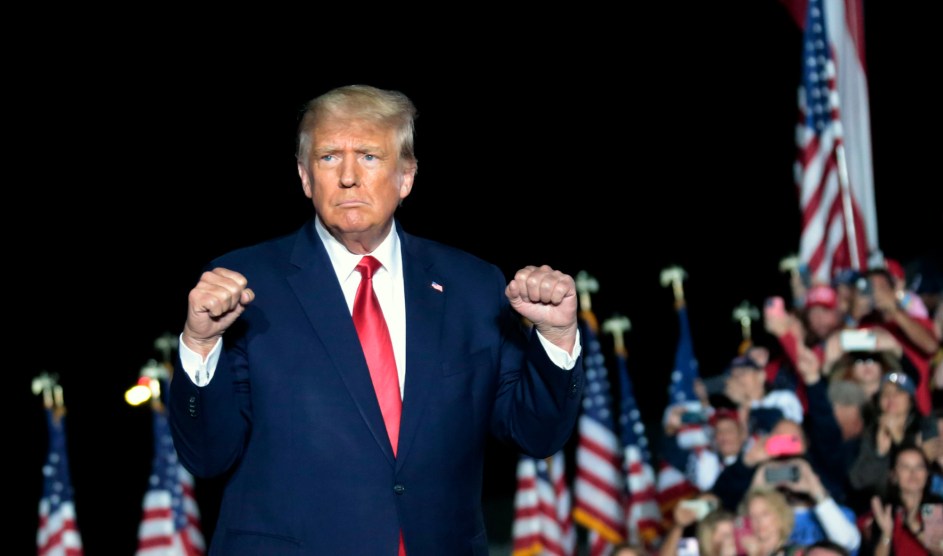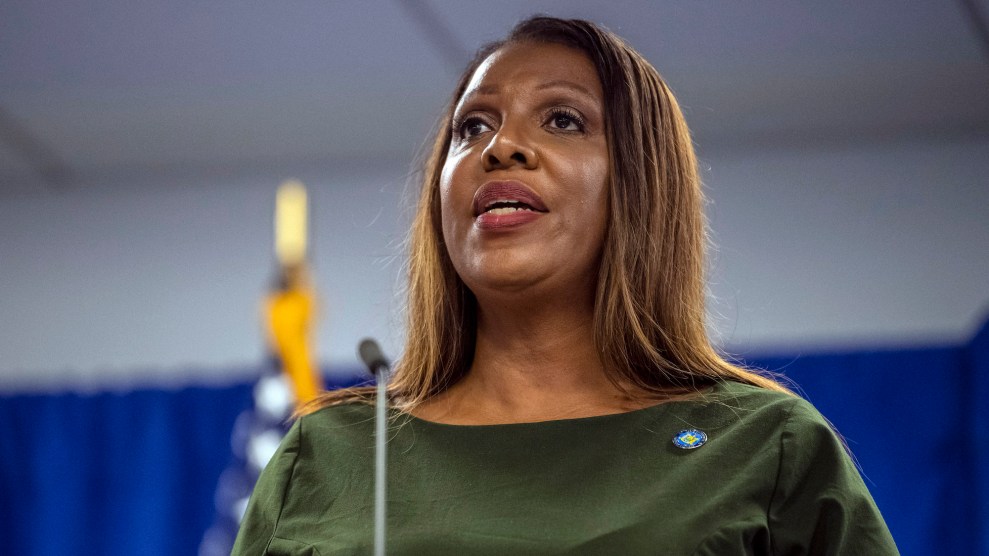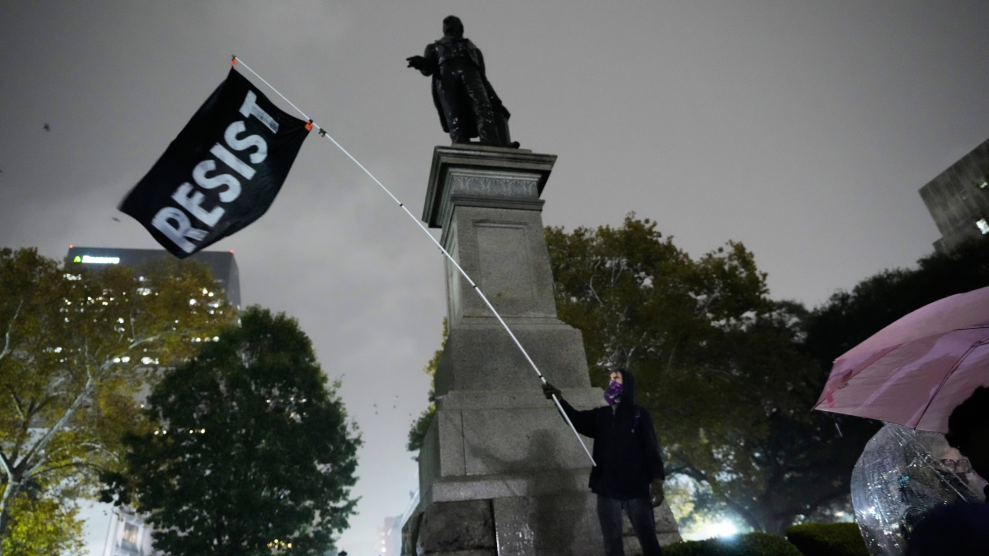
Chris Seward/AP
Donald Trump has always blustered about his wealth. But the $250 million civil fraud lawsuit filed last week by New York’s attorney general paints a truly astonishing picture of the former president’s alleged financial exaggerations.
At his Park Avenue condo building, Trump valued 12 unsold units at $49 million—but they were actually rent-controlled apartments that were unavailable for sale on the market, so their real value was closer to $750,000, according to Letitia James, the state’s AG. Trump figured the value of his Mar-a-Lago resort at around $739 million—perhaps a reasonable number for such a large piece of oceanfront property in Palm Beach if it could be sold as a residence and subdivided to build more homes. But, James alleges, Trump knew very well from the deeds he himself had signed that the property can’t ever be divided up into residential lots. It’s arguably worth about one-tenth of what he told bankers, according to James.
Then there’s his Trump Tower penthouse, which Trump guesstimated was probably worth $327 million—after all, he pointed out to anyone who asked, it was over 30,000 square feet. Except, it wasn’t. According to James, it was only 11,000 square feet, which Trump definitely knew because, as he told everyone, he designed the place himself. Also, only one apartment in New York had ever sold for more than $100 million.
Confronted with the Trump Tower discrepancies, Trump’s longtime chief financial officer, Allen Weisselberg, conceded that the number might have been erroneous by “give or take $200 million.”
These are just a few of the stunning allegations in James’ lawsuit describing how Trump has goosed his numbers for years. After burning his reputation with most big lenders in the 1990s through a string of unpaid debts and corporate bankruptcies, Trump bounced back in the 2000s. But the degree to which he was able to sweet talk lenders into fronting money for his projects left many scratching their heads; during his presidency, it fed conspiracy theories about foreign involvement in his finances. A whole cottage industry sprung up trying to explain how Trump managed to lose so much money running his Scottish golf courses, yet continually valued them each year as being worth more and more money.
According to new details included in James’ suit, the answers were far more simple. Trump did it by just lying to the banks, using nonsensical methods to value the golf courses, and pretending certain things were true when they weren’t—like that the Scottish courses had the potential for thousands of vacation homes to be built on the surrounding land, or that rent-controlled apartments were actually not rent-controlled. Once he had numbers that looked good, James says in her suit, Trump would go to banks and tell them what they needed to hear in order to secure a good loan. In most cases, James argues, when Trump couldn’t get a loan he wanted, he would offer his good name and his personal wealth to back the deal with a personal guarantee. Any skepticism about that good name and wealth would be papered over by providing financial statements that simply weren’t accurate.
The complaint details, for example, how the Trumps routinely approached German banking giant Deutsche Bank’s commercial loan office and were given less-than-favorable loan offers. They would then turn around and make the same requests to the bank’s private wealth management office, a separate division that caters to high-net-worth individuals, which said it would be willing to offer much better terms if Trump promised to personally guarantee the loans. And, as proof that he would indeed be good for the loans that he was guaranteeing, Deutsche’s private wealth office asked for detailed and honest statements of Trump’s personal finances. Those financial statements were deliberately constructed in fraudulent ways, James alleges, to suggest that Trump was far wealthier than he really was, that his businesses were worth far more than they really were, and that they were far more profitable.
The Trumps have protested that James’ lawsuit targets them over things that are standard practice, and that no banks actually were hurt by any misrepresentations. But at a press conference last week, James said the way the family operated was not something that would be acceptable on any other level.
“Everyday people can’t lie to a bank about how much money they have,” James said. “And if they did the government would throw the book at them, why should this be any different? This is a tale of two justice systems—one for everyday working people and one for the elite, the rich and the powerful.”
According to James, nearly all of the loans that Trump got to finance his highest-profile projects—his Doral golf course in Florida, his Chicago hotel and tower, Trump Tower, the 40 Wall Street office building in New York City—were secured with the aid of these financial statements.
The accounting firms that worked for Trump didn’t actually audit any of the data in those statements—they essentially just compiled it and stamped the reports with their name. All of the information came from the Trump Organization itself, and Trump was supposed to certify it as accurate. In some cases, James says, the Trumps falsely told lenders that a valuation had been developed by an independent entity.
In 2011, when Trump wanted to purchase the Doral Resort—a famous but aging course outside Miami—his first approach to Deutsche Bank did not go well. According to James, after talking to the CEO of Deutsche’s securities division about a loan, a banker inside the firm’s commercial real estate division wrote that the resort was “a tough asset and our initial reaction was not enthusiastic.” Still, a few days later, Deutsche’s commercial real estate division offered Trump a $130 million loan—with a minimum interest rate of 10 percent. The commercial bankers at Deutsche apparently didn’t think much of Trump’s plans, and they wanted a lot of money to make up for what they saw as a big risk.
The Trumps didn’t accept that loan, but a few weeks later, Trump and Ivanka Trump met with Rosemary Vrablic, who ran a separate section of Deutsche—the private banking division. This part of the bank was generally more willing to play ball with rich clients, but it all depended on whether they had sufficient wealth to cover their loans. This time when Trump asked for a loan, James says, Vrablic offered him one with a far lower interest rate, which at the time was between 2 and 3 percent. The catch was Trump needed to personally guarantee the whole loan—meaning if he couldn’t make payments, Deutsche could come after his personal assets, not just Doral. To make sure Trump owned enough collateral, he had to certify his own net worth by providing copies of his statement of financial condition. And, the agreement said, he had to continue providing such statements annually so the bank could be assured that he had a net worth of at least $2.5 billion and at least $50 million in liquid assets.
James does not say whether Trump was able to maintain that minimum net worth, but she does include emails from executives at the Trump Organization talking about how worried they were about the terms of the deal.
After advising Ivanka Trump that he was concerned it was too risky for Trump to guarantee the whole loan, longtime Trump Organization attorney Jason Greenblatt added, “Also, the net worth covenants and DJT indebtedness limitations would seem to be a problem?”
According to James’ lawsuit, Ivanka responded that this was the only way the Trumps could get the money they needed.
“We wanted to get a great rate and the only way to get proceeds/term and principle where we want to get them is to guarantee the deal,” she responded.
James cites internal Deutsche Bank records showing that it was the bankers’ evaluation of Trump’s financial statements that persuaded them to accept the future president’s personal guarantee.
As with Doral, James says Trump approached Deutsche Bank’s commercial bank in 2013 looking for a loan to pay for the overhaul and reopening of Washington DC’s iconic Old Post Office building as a luxury hotel. The commercial division once again agreed to loan him the money, but only at a middling interest rate. Again, the private bank stepped in—on the condition that he provide annual financial statements to prove his net worth, Trump was able to get a much lower interest rate.
In Chicago, a similar scenario played out in 2012 when Trump sought to refinance an existing loan from Deutsche’s commercial bank. That division offered to refinance the debt at an interest rate that would be 8 percent above the LIBOR rate (a reference number often used to set interest rates). But the private bank offered to refinance the loan at 4 percent above the LIBOR rate—if he provided his personal guarantee, based on his financial statements.
James says that from 2011 to 2021, Trump sent financial statements to Deutsche annually, certifying his financial health. Thanks to this arrangement, Trump saved anywhere from $85 million and $150 million. James alleges that all of those financial statements were incorrect—and that the Trumps knew it.
The Trumps have denied that they did anything wrong—or anything that the rest of the industry does not do on a regular basis. At her press conference, James said this can’t be true because the degree to which the financial statements were distorted was too big, and the representations too obviously based on bad numbers.
“This conduct can not be dismissed as some sort of good faith mistake,” she said. “The statements of financial condition were grossly inflated, objectively false, and therefore fraudulent and illegal.”
The schemes James alleges are wide-ranging. According to the attorney general, Trump claimed that he had plots of land available north of New York City, ready to develop into fancy mansions that he could sell for tens of millions of dollars apiece—while simultaneously claiming that he had agreed not to develop the land and keep it as green space in exchange for tax breaks. From 2014 to 2018, according to the suit, Trump based the value of retail space he controlled on numbers he said were provided by outside professional—but there was no outside professional.
Trump’s approach to golf courses appeared even more arbitrary. He has poured hundreds of millions of dollars into purchasing and developing a network of courses, but the properties have not all been particularly profitable. That’s not too unusual—the business of running a golf course isn’t as lucrative as developing the housing around a golf course, which is generally what Trump has intended to do with his most prominent courses. When it came to valuing the courses, James says she has evidence that Trump was told by outside consultants to use a method that focused on how much money the courses actually made. In the case of his Scottish courses, which have never, ever come close to turning a profit, he declined to take the advice.
Instead, Trump used a valuation method that took into account how much money he had sunk into developing the courses. But as devoted as he was to using this method to compile the annual financial statements he used to get loans from banks, he did a 180-degree turn when it was time to pay taxes. In fact, James says, Trump’s attorneys argued strongly to the IRS in 2012 and on other occasions that the only fair way to value the courses was to consider how much money they did—or didn’t—make.
Like with his golf course outside of New York City, Trump told banks that his Scottish golf courses had huge development potential. Trump estimated that his Aberdeen resort was reasonably valued at $327 million—thanks largely to his ability to develop 2,500 homes alongside the course he had built there. But, in reality, Trump had only gotten planning permission to build 1,500 homes, not all of them for year-round use as homes. None of those homes have actually been sold in the more than a decade that Trump has owned the property. In 2020, a local reporter told Mother Jones he couldn’t figure out why anyone would spend the sums Trump was bragging the homes would be worth—the location on the stormy North Sea coast of northeastern Scotland isn’t the most likely place to build a resort community:
In a statement on the day James announced her suit, the Trump Organization dismissed it as a politically motivated stunt.
“While the job of the Attorney General is to protect the interests of the public, today’s filing, for the first time in the history of the Attorney General’s office, seeks to protect the interests of large, sophisticated Wall Street banks,” a spokesperson said in a statement. “However, not only was no bank harmed—actually, they profited handsomely—to the tune of hundreds of millions of dollars in interest and fees—and never once took issue with any of the loans in question—all of which are either current or have been paid off (in many cases early).”
Since James began investigating the Trumps, several of the loans she was looking at have indeed been paid off—either outright in the case of the Old Post Office hotel, which Trump recently sold; or refinanced, in the case of Trump Tower. Trump doesn’t appear to have ever missed payments on any of the loans that James investigated. But, James says, that doesn’t mean he didn’t improperly benefit by getting a lower interest rate, and paying less over the years, by using a personal guarantee that really wasn’t what it seemed.
James’ lawsuit doesn’t just detail how she says the Trumps faked their numbers to help get business benefits they didn’t deserve. She says they went out of their way to conceal it.
“I want to be clear, white collar financial crime is not a victimless crime,” she said at her presser. “When the well-connected break the law to take in more money than they are entitled to, it reduces resources to working people, regular people, small businesses and all tax payers.”

















